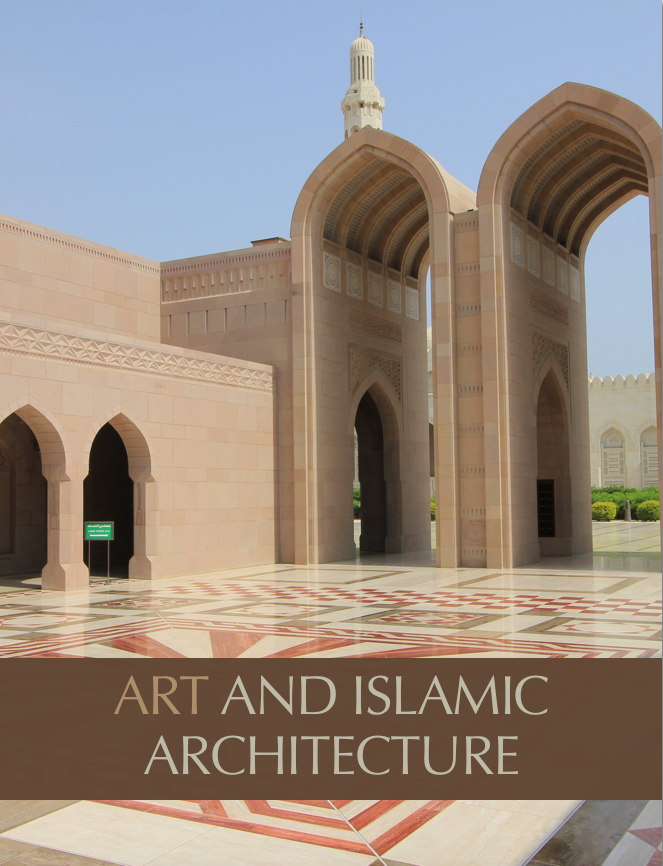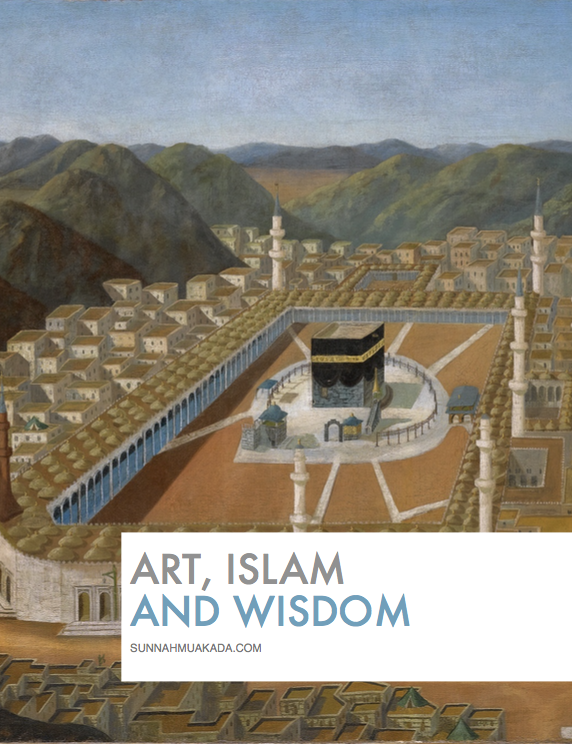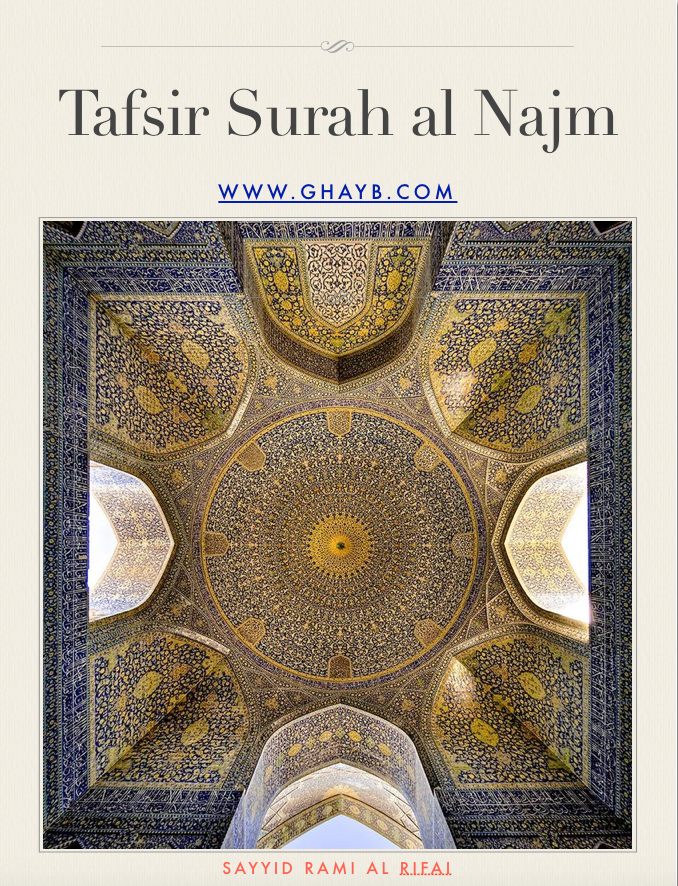My Other Books
Art and Islamic Architecture

The Essence of Islamic Art
From the first thousand years of Islam, since the first revelations to the Prophet Muhammad (pbuh) to the great Islamic empires of the eighteenth century, Islamic civilization flourished, Muslims made remarkable advances in philosophy, science, medicine, literature, and art. The uniting of so many diverse cultures under one religion allowed for the quick dissemination of the latest discoveries to all parts of the Islamic realm. Paper making from China, “Arabic” numerals from India, classical science and philosophy, along with significant contributions in chemistry, physics and mathematics were all quickly shared via the trade routes the Islamic international civilization had established from Western Africa and Europe to Asia. Islam fostered the development of a distinctive culture with its own unique artistic language that is reflected in art and architecture throughout the Muslim world.
Gradually, under the impact of the Muslim faith a uniquely Islamic art began to emerge. The rule of the Umayyad caliphate (661–750) is often considered to be the formative period in Islamic art. One method of classifying Islamic art, is according to the dynasty reigning when the work of art was produced. This type of periodization follows the general precepts of Islamic history, which is divided into the rule of various dynasties, beginning with the Umayyad and Abbasid dynasties that governed a vast and unified Islamic state from Africa to the borders of India and China, and concluding with the more regional, though powerful, dynasties such as the Safavids, Ottomans, and Mughals.
With its geographic spread and long history, 1400 years, Islamic art was subject to a wide range of regional and even national styles and influences as well as changes within the various periods of its development, the principles of Islam where applied to local culture to produce unique works, each region of the world flourishing at various periods in Islam’s history.
Even under these circumstances and influences of varying world cultures, Islamic art has always retained its intrinsic quality and unique identity, whether the artisan was African, Arabian, Persian or Indian in origin. Islam embodies a way of life people throughout its lands are committed to, historically it served as a cohesive force among ethnically and culturally diverse peoples among the many nations it was found in, Islam was the common language and the art produced by and for Muslim societies had basic identifying and unifying characteristics. Perhaps the most salient of these is all-over surface decoration. The four basic components of Islamic ornament are calligraphy, vegetal patterns, geometric patterns, and figural representation.
Surface patterns on works of art created in the Islamic world have been prized for centuries for their beauty, refinement, harmony, intricacy, and complexity.
Geometric motifs were popular with Islamic artists and designers in all parts of the world, for decorating almost every surface, whether walls or floors, pots or lamps, book covers or textiles. Islamic artists combined geometry with existing local traditions, creating a new and distinctive Islamic art that expressed the logic and order of the universe.
The study of geometry fed an ardent preoccupation with the stars celestial bodies and astronomy. All this in turn nourished the Arabic passion for creating infinite, decorative patterns. The cultivation of mathematical analysis, in particular, had a harmonizing effect. Islam cultivated the abstract study of the universe and the environment, this combined with it’s related doctrine of harmony with the universe and its creator (Tawhid), allowed Muslim intellectuals to recognize in geometry the unifying intermediary between the material and the spiritual world.
The development of this new distinctive art, in part may have been due to the discouragement of portraying animate objects in Art on the basis that it leads to idolatry and the psychological sicknesses in society associated with it. The Heart of man was created to embody noble attributes and in this way man through his qualities and individual personality will know his creator.
Tawhid in its perfected form is the harmony of man with his environment, if man’s self is not in harmony with his surroundings and at peace then he is blind to his creator who manifests himself through his creation, man’s otherwise turbulent nature would blind his perception and he would be dominated by emotions such as anger, hate and lust.
How can man recognize the value of peace if he thirsts to satisfy his desire, in this way and because of the effect of idols in their many forms have on society, whether movie stars or pop idols, the prophet (saws) said in relation to animate objects in art “Those who make pictures (of them) will be punished on the day of judgment. It will be said to them: Bring to life what you have created!”
This is because they have challenged God’s place within man’s heart, so on that day they will be challenged in turn because of the false nature of the idol and its effects of stoping man from ennobling himself.
Muslim’s held the belief that the Heart of Man is the throne of the Merciful (“Qalb al Insan Arsh al Rahman”), because of the hearts role to acquire noble qualities by which man perceives the world and its creator and then shapes it according to his vision.
For Muslims this is the reality of the fundamental formula of Islam “There is no divinity other than God” (“La ilaha illah Llah”), meaning there should not be in mans heart anything greater than God. Muslims “see in figurative art, a fundamental error or illusion in projecting the nature of the absolute into the relative, by attributing to the relative an autonomy that does not belong to it. In this way, Islamic artists did not seek to express themselves as such, but rather aimed to ennoble matter and its natural order”.
In relation to this Allah said to man “Have you seen him who chooses, for his god his own lust? (25:43), “For indeed it is not the eyes that grow blind, but it is the hearts, which are within the bosoms, that grow blind” (22:46).
This inner blindness about which the prophet Muhammad (saws) explained, “Indeed Allah does not look at your appearance or form, but rather Allah looks at your Heart”, Allah judges man by the quality of his heart whether it embodies beautiful attribute’s or wretched ones. These teachings served to direct mans energy and capacity towards the things which would spiritually and materially benefit him in life through the creation of a balanced society.
Instead of covering buildings and other surfaces with human figures, Muslim artists developed complex geometric decorative designs, as well as intricate patterns of vegetal ornament (such as arabesque), with which to adorn palaces and mosques and other public places.
The development of infinitely repeating patterns was used to represent the unchanging laws God placed in nature, as He said “AND [remember:] We have not created the heavens and the earth and all that is between them without [an inner] truth” (15:85). In this way the rules of construction of geometric patterns provide a visual analogy to religious rules of behavior.
Both the contemplation of and the creative skill in making patterns lead in their own way to an understanding of the perfection found in Nature as it moves the elements, either a mathematical representation of nature or the moon in its orbit. Islamic patterns, unique as an art form, was unitary in its aim and function, the symbols inherent in Islamic patterns and geometry express the connection between the material and spiritual world, the world of Angels and the world of Man, they bring to life what is expressed in metaphors and allegory and are directed towards that undifferentiated unity between the two worlds.
“We have explained in detail in this Qur’an, for the benefit of mankind, every kind of similitude: but man is, in most things, contentious (18:54)
Art Islam and Wisdom

Art, Islam and Wisdom is an art book created to display Islamic art. The first chapter displays art created by my self inspired by modern influences, the second chapter display’s Islamic Art in Armour and Weapons from the Islamic world including the weapons of the Prophet (saws). The final Chapter contains art relating to the Hilya of the Prophet Muhammad (saws), Quranic and Hadith Manuscripts as well some of the Prophets (saws) relics.
Al Fiqh Al Akbar: An Accurate Translation

Modern translations of Imam Abu Hanifa’s al Fiqh al Akbar have attributed anthropomorphic (claiming that Allah has a form or body) views to the Imam. Salafi’s have claimed such beliefs regarding the Imam, despite the fact his most famous work on Aqeedah (Theology) was written to refute the heretical sects that arose in his time claiming the Anthramorphism of Allah, and to clearly define the Aqeedah of Ahl al Sunnah wal Jama’ah (Islam). This Work presents an accurate translation of al Fiqh al Akbar along with a discussion on the history of Aqeedah in relation to the work.
Islam and Children

When my niece was born about a year ago my family asked me to write a book on children and Islam, while this book isn't completely an original work it is taken from chapters in The Islamic Journal and arranged specifically for this subject, to which i have added much from Imam Ghazali's great work Ihya Ullum al Deen.
Bismillah Rahmani Raheem
The Prophet Muhammad (s) said: “Every one of your (people) is responsible, and everyone is responsible for whatever falls under his responsibility. A man is like a shepherd of his own family, and he is responsible for them” (Bukhari and Muslim).
The Messenger of Allah (Allah bless him and give him peace) said, “When a Muslim dies, his actions are cut off from him except from three, continual charity (sadaqa jariya), knowledge he benefited from or a righteous child who supplicates for him” [Muslim]
The biggest flaw in modern education is their reduction of knowledge and wisdom into facts and lists of points on a piece of paper, a person through life tries to gain wisdom about everything in it, and wisdom on any topic is only gained by acquiring much knowledge about it, yet modern education stops teaching matters at points, facts and lists.
When knowledge is reduced to facts it quickly becomes a list of points to be memorized and the wisdom behind anything you do is lost, so all the acts we do in the religion become a hollow mindless shell of what they used to be because a person doesn’t know why he is doing anything, how can you cure the heart of sickness if you can’t involve your heart in what you are doing by motivating it with the wisdom behind the act, and for this you need to know why you are doing it.
It is for this reason the book is structured this way, we can teach our children lists of points on a piece of paper which we can read from any other book, but with this book we will be able to explain to them why we do everything in Islam.
The Book has three parts, the first explains the wisdom behind different things in the religion and this is based of my work in “The Islamic Journal”, which you can find at my website Ghayb.com, then it talks about raising children and this is based of others work and the last section deals with the Pillars of Islam, why we follow them and what we try to achieve with them, they are from the work of Imam al Ghazali found in the book “Inner Dimensions Of Islamic Worship” and cover Prayer, Zakat, Sawm, Hajj, the Night prayer and other acts of Ibadah (worship), they are very deep and the sum of Islam’s wisdom. After all this we will be able to teach children the most important things in Islam when they get older or even just give them this book, wisdom is more important than anything else we can give them and Allah said about it in the Quran:
“He granteth wisdom to whom He pleaseth; and he to whom wisdom is granted receiveth indeed a benefit overflowing; but none will grasp the Message but men of understanding.”(2:269)
Tafsir Surah al Najm

Allah often in the Quran mentions six, seven, nine, twelve or more scientific themes one after the other to draw the bigger picture of life. In this surah Allah does this to defend the prophet (saws) from the accusation levelled at him by the pagans that He is incapable of receiving revelation, but He also does something very unique which we will show by the end of the Tafsir.
The Hidden meanings in the Quran relate to the scientific themes Allah is mentioning in each verse and how those topics then scientifically relate to each other, because this is Allah’s knowledge of the Universe and every word of Allah is deliberate and purposefully phrased, this Tafsir goes through these themes verse by verse to show the deeper side of Allah's words that were hidden until our time of science...“In time We shall make them fully understand Our messages”…(Quran 41:53)
How Islam Shaped The Modern World

This book is the first two issues of the Islamic Journal compiled in this format because of the topics they cover.
When the question is asked what are Islam’s contributions to civilization, often the focus is on scientific development, to the ancient world this is by far the most misleading standard for advancement and development. While Islam was certainly the most advanced civilization of the ancient world it’s social and moral development is what set it apart from the rest of the world.
Social and moral development in the ancient world had a far more significant impact on a society than scientific development, although still important in many ways, this is because ideology changed how the entire community behaved and lived their lives.
Social development establishes how people are treated in a society and how that society views and treats those different from them, moral development drives social development because it defines the framework for how that society should live and spend it’s time and energy, this is very important when the backdrop in the ancient world was either living as hunter gatherers or a nomadic life.
As the world at large moved away from this Islam was instrumental in shaping the development of the entire world, it was a trade empire whose borders stretched from west Africa and southern Europe to China, it’s scientific advancements which surpassed the rest of the world where a direct result of changing communities and societies around the world and encouraging them to study nature and the world, this global effort would spread around the world from Europe to Asia to the Americas.
This book looks at what it is in Islam that encouraged this change in so many communities, it discusses the spirituality that shaped so many lives.
Some of these societies where among the most primitive people on earth but in a short period of time they would set up large empires spanning multiple continents, this processes was seen numerous times in Islam’s history in different regions of the earth.
From the Ummayids who first invaded Europe, to the African Mali Empire whose most famous ruler was the richest person in History, to the Ottomans who had one of the largest Empires on earth and one of the longest lasting family dynasties, all had simple beginnings but one thing in common that changed their societies in a short period of time.

